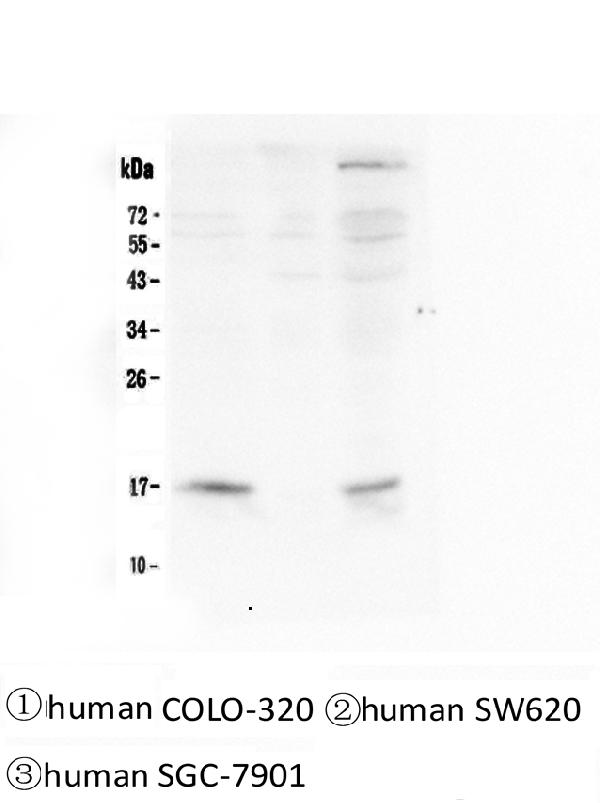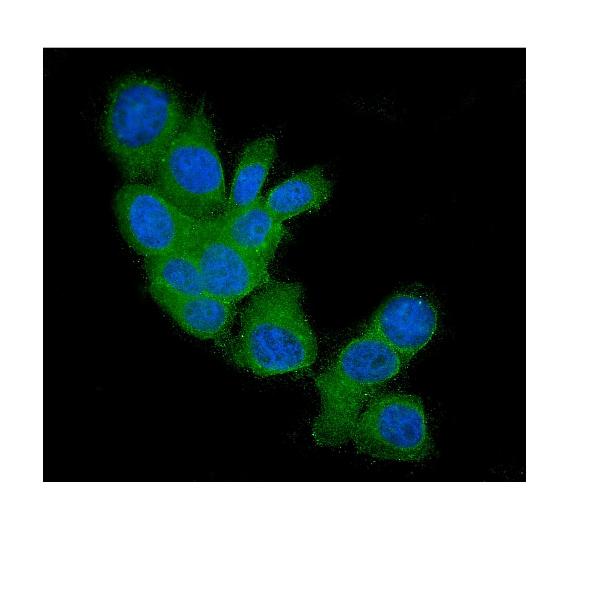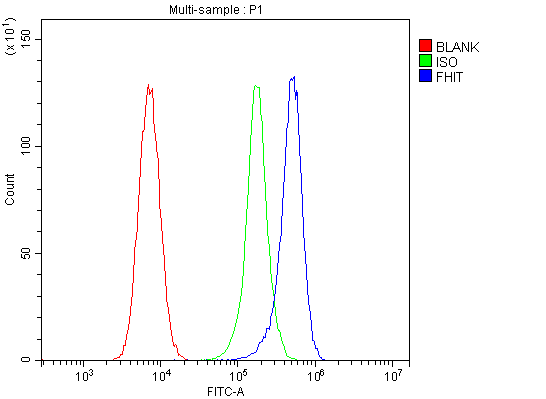Anti-FHIT Antibody Picoband™ (monoclonal, 26H7)
- SPECIFICATION
- CITATIONS
- PROTOCOLS
- BACKGROUND

Application
| WB, IF, ICC, FC |
|---|---|
| Primary Accession | P49789 |
| Host | Mouse |
| Isotype | Mouse IgG1 |
| Reactivity | Human |
| Clonality | Monoclonal |
| Format | Lyophilized |
| Description | Anti-FHIT Antibody Picoband™ (monoclonal, 26H7) . Tested in Flow Cytometry, IF, ICC, WB applications. This antibody reacts with Human. |
| Reconstitution | Add 0.2ml of distilled water will yield a concentration of 500ug/ml. |
| Gene ID | 2272 |
|---|---|
| Other Names | Bis(5'-adenosyl)-triphosphatase, 3.6.1.29, AP3A hydrolase, AP3Aase, Adenosine 5'-monophosphoramidase FHIT, 3.9.1.-, Adenylylsulfatase, 3.6.2.1, Adenylylsulfate-ammonia adenylyltransferase, 2.7.7.51, Diadenosine 5', 5'''-P1, P3-triphosphate hydrolase, Dinucleosidetriphosphatase, Fragile histidine triad protein, FHIT |
| Calculated MW | 17 kDa |
| Application Details | Western blot, 0.1-0.5 µg/ml Immunocytochemistry/Immunofluorescence, 2 µg/ml Flow Cytometry, 1-3 µg/1x10^6 cells |
| Subcellular Localization | Cytoplasm. Mitochondrion. Nucleus. |
| Tissue Specificity | Low levels expressed in all tissues tested. Phospho-FHIT observed in liver and kidney, but not in brain and lung. Phospho-FHIT undetected in all tested human tumor cell lines. |
| Contents | Each vial contains 4mg Trehalose, 0.9mg NaCl, 0.2mg Na2HPO4, 0.05mg NaN3. |
| Clone Names | Clone: 26H7 |
| Immunogen | E.coli-derived human FHIT recombinant protein (Position: M1-Q147). Human FHIT shares 90% and 87% amino acid (aa) sequence identity with mouse and rat FHIT, respectively. |
| Cross Reactivity | No cross-reactivity with other proteins. |
| Storage | Store at -20˚C for one year from date of receipt. After reconstitution, at 4˚C for one month. It can also be aliquotted and stored frozen at -20˚C for six months. Avoid repeated freeze-thaw cycles. |
| Name | FHIT |
|---|---|
| Function | Possesses dinucleoside triphosphate hydrolase activity (PubMed:12574506, PubMed:15182206, PubMed:8794732, PubMed:9323207, PubMed:9543008, PubMed:9576908). Cleaves P(1)-P(3)-bis(5'-adenosyl) triphosphate (Ap3A) to yield AMP and ADP (PubMed:12574506, PubMed:15182206, PubMed:8794732, PubMed:9323207, PubMed:9543008, PubMed:9576908). Can also hydrolyze P(1)-P(4)-bis(5'-adenosyl) tetraphosphate (Ap4A), but has extremely low activity with ATP (PubMed:8794732). Exhibits adenylylsulfatase activity, hydrolyzing adenosine 5'-phosphosulfate to yield AMP and sulfate (PubMed:18694747). Exhibits adenosine 5'-monophosphoramidase activity, hydrolyzing purine nucleotide phosphoramidates with a single phosphate group such as adenosine 5'monophosphoramidate (AMP-NH2) to yield AMP and NH2 (PubMed:18694747). Exhibits adenylylsulfate-ammonia adenylyltransferase, catalyzing the ammonolysis of adenosine 5'- phosphosulfate resulting in the formation of adenosine 5'- phosphoramidate (PubMed:26181368). Also catalyzes the ammonolysis of adenosine 5-phosphorofluoridate and diadenosine triphosphate (PubMed:26181368). Modulates transcriptional activation by CTNNB1 and thereby contributes to regulate the expression of genes essential for cell proliferation and survival, such as CCND1 and BIRC5 (PubMed:18077326). Plays a role in the induction of apoptosis via SRC and AKT1 signaling pathways (PubMed:16407838). Inhibits MDM2-mediated proteasomal degradation of p53/TP53 and thereby plays a role in p53/TP53-mediated apoptosis (PubMed:15313915). Induction of apoptosis depends on the ability of FHIT to bind P(1)-P(3)-bis(5'-adenosyl) triphosphate or related compounds, but does not require its catalytic activity, it may in part come from the mitochondrial form, which sensitizes the low-affinity Ca(2+) transporters, enhancing mitochondrial calcium uptake (PubMed:12574506, PubMed:19622739). Functions as a tumor suppressor (By similarity). |
| Cellular Location | Cytoplasm. Mitochondrion. Nucleus |
| Tissue Location | Low levels expressed in all tissues tested. Phospho-FHIT observed in liver and kidney, but not in brain and lung Phospho-FHIT undetected in all tested human tumor cell lines |

Thousands of laboratories across the world have published research that depended on the performance of antibodies from Abcepta to advance their research. Check out links to articles that cite our products in major peer-reviewed journals, organized by research category.
info@abcepta.com, and receive a free "I Love Antibodies" mug.
Provided below are standard protocols that you may find useful for product applications.
Background
Bis (5'-adenosyl)-triphosphatase, also known as fragile histidine triad protein (FHIT) is an enzyme that in humans is encoded by the FHIT gene. This gene, a member of the histidine triad gene family, encodes a diadenosine P1,P3-bis (5'-adenosyl)-triphosphate adenylohydrolase involved in purine metabolism. The gene encompasses the common fragile site FRA3B on chromosome 3p14.2, where carcinogen-induced damage can lead to translocations and aberrant transcripts of this gene. In fact, aberrant transcripts from this gene have been found in about half of all esophageal, stomach, and colon carcinomas. Furthermore, FHIT has been shown to synergize with VHL, another tumor suppressor, in protecting against chemically - induced lung cancer. It also acts as a tumor suppressor of HER2/neu driven breast cancer.
If you have used an Abcepta product and would like to share how it has performed, please click on the "Submit Review" button and provide the requested information. Our staff will examine and post your review and contact you if needed.
If you have any additional inquiries please email technical services at tech@abcepta.com.













 Foundational characteristics of cancer include proliferation, angiogenesis, migration, evasion of apoptosis, and cellular immortality. Find key markers for these cellular processes and antibodies to detect them.
Foundational characteristics of cancer include proliferation, angiogenesis, migration, evasion of apoptosis, and cellular immortality. Find key markers for these cellular processes and antibodies to detect them. The SUMOplot™ Analysis Program predicts and scores sumoylation sites in your protein. SUMOylation is a post-translational modification involved in various cellular processes, such as nuclear-cytosolic transport, transcriptional regulation, apoptosis, protein stability, response to stress, and progression through the cell cycle.
The SUMOplot™ Analysis Program predicts and scores sumoylation sites in your protein. SUMOylation is a post-translational modification involved in various cellular processes, such as nuclear-cytosolic transport, transcriptional regulation, apoptosis, protein stability, response to stress, and progression through the cell cycle. The Autophagy Receptor Motif Plotter predicts and scores autophagy receptor binding sites in your protein. Identifying proteins connected to this pathway is critical to understanding the role of autophagy in physiological as well as pathological processes such as development, differentiation, neurodegenerative diseases, stress, infection, and cancer.
The Autophagy Receptor Motif Plotter predicts and scores autophagy receptor binding sites in your protein. Identifying proteins connected to this pathway is critical to understanding the role of autophagy in physiological as well as pathological processes such as development, differentiation, neurodegenerative diseases, stress, infection, and cancer.




